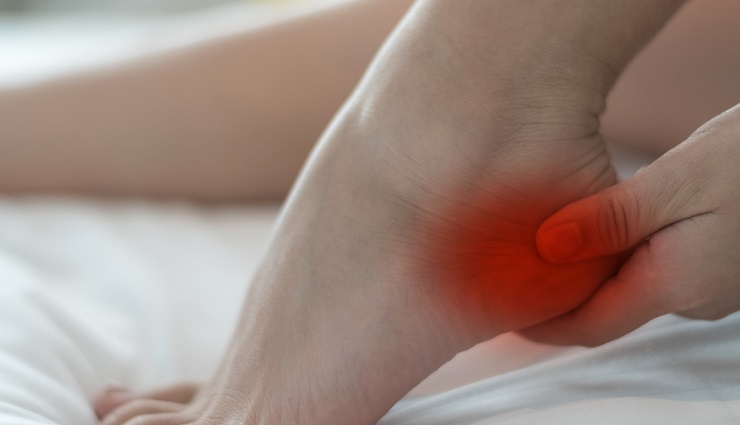Heel pain can interfere with your daily activities and make tasks that require walking or standing difficult. It causes heel pain in many types; this complication affects many people yearly. One of the leading causes of heel pain is plantar fasciitis, which can be treated with simple home exercises and over-the-counter medications. Continue reading to learn more about the causes, symptoms, and treatments for heel pain.
What is plantar fasciitis?
Sometimes the cause of heel pain is plantar fasciitis. This pain is felt under the heel. The plantar fascia is a thick, rubber-band-like ligament that connects the heel bone to the front of the foot and is responsible for absorbing shock and supporting the foot’s arch. Heel pain is one of the most common orthopedic complications because this ligament endures a lot of pressure daily. This pressure may damage or tear the ligaments. When the plantar fascia becomes inflamed, this inflammation causes heel pain and stiffness.
The cause of this complication is still unknown. Of course, according to research in 2003, inflammation of the plantar fascia is caused by degeneration rather than inflammation. Of course, anything that puts pressure on this ligament causes inflammation, making walking and using the foot pain. Most people usually have heel pain in only one foot, but both feet may be affected simultaneously.
Symptoms of plantar fasciitis
The main symptom of plantar fasciitis is heel pain, which is felt mainly in the morning. The cause of heel pain when waking up is that when a person wakes up in the morning and walks after hours of immobility, the inflamed ligament undergoes microscopic tears. Some other symptoms of this condition are:
- inflammation;
- Hardness;
- pain in the arch of the heel or the bottom of the foot;
- Pain that worsens after activity rather than during it;
- Tight Achilles tendon.
Pain from plantar fasciitis develops over time and may be sharp or dull. Some people feel pain or burning sensation under their feet that extends to the heel. Climbing the stairs will also be difficult due to the stiffness of the heel. After prolonged activity, pain may worsen due to irritation or inflammation.
What does plantar fascia feel like?
Plantar fascia usually causes the heel and lower leg to stretch. This pain varies based on what you are doing and the time of day. Some types of pain you may feel include:
- When you have pain when you stand up after sleeping or sitting for a while, this pain usually disappears after a few minutes of walking.
- Constant dull pain.
- Sharp and shooting pain is felt when using the patient’s foot or pressing the heel.
- When exercise or movement temporarily relieves the pain, it usually worsens when it is stopped.
The cause of heel pain and plantar fascia
Anything that irritates and damages the plantar fascia may inflame it and cause heel pain. For example:
- Walking all day;
- Exercise;
- Exercising or working on hard surfaces (such as sidewalks or warehouses);
- Exercise without warming up the body ;
- She is wearing shoes that do not support the feet well (such as flip-flops or flat, flexible shoes).
These people are more prone to heel pain:
- Overweight or obese people. Pain is caused by increased pressure on the leg ligament, especially if there is sudden weight gain (for example, due to pregnancy ).
- the runners
- People with foot problems, such as flat feet or heel spurs.
- People who wear soft-soled shoes.
Plantar fascia diagnosis methods

To diagnose this condition, the doctor will examine you to determine the sensitivity to touch and the exact location of the pain. By doing this, it is determined whether the cause of heel pain is another complication or not. During the exam, your doctor may ask you to lift your big toe while pressing on the plantar fascia to see if the pain worsens when you contract the foot. It also takes into account mild redness and inflammation.
The doctor measures muscle strength and nerve health with these methods:
- involuntary responses;
- ability to contract muscles;
- sense of touch and sight;
- coordination of organs;
- the balance.
Usually, no diagnostic tests are needed to diagnose plantar fasciitis. Of course, he may use imaging methods to rule out diseases and other causes of pain. Some of these photography methods are:
- x-ray;
- ultrasound ;
- MRI.
Treatment of plantar fasciitis
If you have plantar fasciitis, treating heel pain at home is possible. Treatments such as rest and cold compresses, splints, and anti-inflammatory medications are usually the first step in treating plantar fasciitis heel pain at home. If these do not relieve pain, direct injection of corticosteroids into the affected part of the plantar ligament can be helpful. This is done in the doctor’s office. In the following, we describe some treatments for plantar fasciitis.
Non-surgical treatments for plantar fasciitis
1. Physiotherapy
Physiotherapy is an important measure to treat this condition. This will help stretch the plantar fascia and Achilles tendon. A physical therapist can suggest exercises that strengthen the lower leg muscles, improve walking, and reduce stress on the ligaments.
2. Shock wave therapy
If the pain persists and other methods are ineffective, your doctor may recommend shockwave therapy. In this treatment, sound waves are injected into your heel to stimulate the healing of the ligament. The side effects of this treatment are:
- bruises ;
- inflammation;
- the pain;
- numb.
However, remember that shock wave treatment does not permanently cure heel pain.
3. exercise
Light exercises usually cure or even prevent plantar fasciitis. Softening the back and soles of the feet may cause muscle expansion and reduce heel pain. Of course, not doing other sports like running is also very important for the healing of plantar fascia. Swimming and other light sports allow you to exercise without worsening heel pain. If you start running again, start slowly.
Be sure to soften it before exercising to prevent heel pain from returning. Heel pain remedies are easy. You will only need simple tools, such as a chair, a rolling pin, or a frozen water bottle.
4. platelet-rich plasma (PRP)
PRP is usually injected into the heel and treats the injuries.
Surgical treatment for plantar fasciitis
Surgery is the most invasive method to treat this condition and is performed only if the pain is very severe or continues for more than 6 to 12 months. Surgery can cause chronic pain and nerve damage; For this reason, it is usually the last treatment option.
1. Recession of the typical nerve
If it is difficult to contract the leg even after continuous stretching, the doctor may suggest surgery to resect the nerve of the joint muscle. This surgery involves lengthening the nerve in the back of the foot to increase ankle movement and flexibility and reduce pressure on the plantar fascia.
In a 2018 study, 17 overweight or obese patients with chronic plantar fascia inflammation improved their foot function and decreased pain by performing this surgery.
2. Release of the plantar fascia
In this surgery, the surgeon cuts a part of the plantar fascia ligament to reduce the tension created in it and reduce inflammation. This may involve cutting a small portion of the ligament or separating the plantar fascia from the heel bone. This surgery is performed as an open surgery or through endoscopy. Of course, reducing this pressure causes weakness of the heel arch and may disrupt its function.
Home treatment of plantar fasciitis
Reducing the pain, irritation, and inflammation of the plantar fascia ligament is an integral part of treatment, but it does not address the underlying cause of the ligament damage. The initial treatment of this condition includes rest and a cold compress to reduce inflammation for 15 to 20 minutes, 3 or 4 times a day. You can also change your exercise routine. Using heel support in shoes, replacing old sports shoes, and exercising may also reduce heel pain. Non-steroidal anti-inflammatory drugs such as ibuprofen and naproxen can also reduce ligament pain.
1. Subcutaneous tenotomy with a needle
In subcutaneous tenotomy, the doctor inserts needles through the skin into the plantar fascia. By doing this, the body sends more blood to the area, which causes the ligament to heal faster.
2. Splint and support

Night splints are another treatment that helps stretch the arch and arch of the foot. These splints stretch the foot and cause the Achilles tendons and plantar fascia to try at night. This prevents morning stiffness and soreness.
Special orthotics or arch supports can also spread the pressure on the heel and prevent further damage to the plantar fascia. A removable cast also immobilizes your leg and prevents pressure on it while it heals. You can take off this cast like a boot to take a bath.
3. Aromatic oils
According to some research, massage with aromatic oils can reduce pain and inflammation caused by complications. These oils are:
- Lavender ;
- lemon grass ;
- Eucalyptus ;
- rose.
Before massaging, dilute your essential oils with another oil, such as coconut oil. You can also use these aromatic oils with hot water.
4. Cannabidiol or CBD oil
Cannabidiol oil is a compound found in the cannabis plant and used in compounds used to treat pain and inflammation. This oil can be used to treat all types of chronic pain, and inhalation of its incense is used for chronic neuropathic pain. Of course, it is better to consult your doctor about the appropriate dosage and other details before using this oil.
5. Nutrients and supplements
The use of some supplements can have a positive effect on the healing and improvement of plantar fascia inflammation, such as:
- Vitamin C;
- zinc (zinc);
- Glucosamine;
- permalink;
- fish oil
It is better to get nutrients from a healthy diet, not supplements. If you decide to use supplements, consult your doctor first. If weight gain has caused plantar fasciitis, eating a healthy diet can help you lose weight and reduce heel pain.
How long does plantar fasciitis heal?
In most people, plantar fasciitis improves after a few months of using home remedies. These treatments include rest, cold compresses, and relaxation. You can also recover faster by immobilizing your leg.
Prevention methods of plantar fascia inflammation
Some minor lifestyle changes can prevent this complication. For example, using the right shoes that provide proper support for the arch of the foot and changing shoes regularly can be helpful for you. Changing your shoes every 800 km is better if you are a runner.
Including non-jump sports such as swimming or cycling in your schedule is good. You can avoid stressing your plantar fascia by avoiding constant running. Before exercising, warm up your back muscles, Achilles tendon, and plantar fascia with soft. It is also better to try to maintain a healthy weight. If you’re overweight, lose weight to put less pressure on your plantar fascia.
Are fasciitis and heel spurs the same?
Both cause heel pain, but they are different complications. A heel spur is a bony appendage that protrudes from the bottom of the heel, where the heel bone attaches to the plantar fascia. This complication may occur due to pressure and inflammation caused by plantar fascia inflammation. Most people do not feel pain due to heel spurs, but when they do, it is like the pain of plantar fasciitis.
final word
One cause of heel pain is inflammation of the plantar fascia, which may be caused by excessive pressure on the heel. In most people, this condition does not cause many problems and can be improved with simple home remedies. If this complication is not treated, the inflammation of this ligament may become a chronic disease and require more aggressive treatments such as surgery. Adequate rest, proper weight maintenance, cold water compresses, and special exercises are most important in improving these conditions.
Warning! This article is only for educational purposes; to use it, it is necessary to consult a doctor or specialist.



